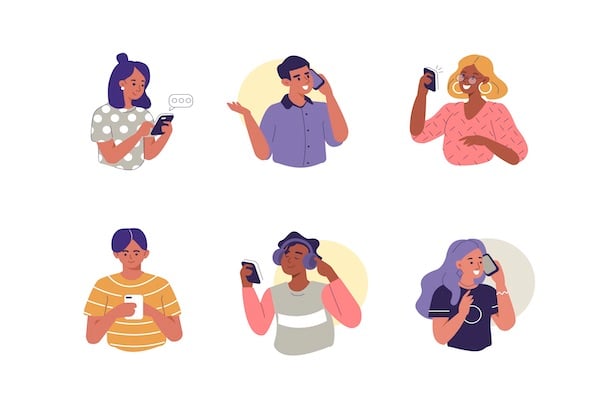In this post, I’ll share a buffet of best practices to transform your lunch and learns into highly anticipated events that benefit your service teams and, by extension, your customers.
Table of Contents
What is a lunch and learn?
A lunch and learn is a professional event where teammates or entire departments come together for a meal during the work day (typically paid for by the company) to grow their skills. Lunch and learns can be recurring or stand-alone events, depending on your goals.
Lunch and learns are typically used for professional development, but these events are flexible. I’ve been to lunch and learns for new product rollouts, updates on company policy, and general discussions on the future of our customer service department.
My experience with lunch and learns comes from the world of customer support. While any team can benefit from swapping knowledge over sandwiches, I’ve found that support reps especially thrive in these environments. Customer support is a fast-paced and heavily experiential ecosystem where reps must balance multiple tools, strategies, and changing customer expectations. Lunch and learns are the perfect opportunity for reps to share strategies and experiences so the team can stay ahead of the curve.
Sure, you could email or drop a link to a training video in Slack, but where’s the fun in that? I’ve found that lunch and learns are more engaging than traditional training mediums, and there’s just something about free food that makes the information stick.
Benefits of a Lunch and Learn
In my experience working at HubSpot support, I’ve seen firsthand how lunch and learns improve team skills and boost morale, all in service of the customer experience.
1. Efficiency
I didn’t have much downtime when I was working in support. I was constantly on the phone with customers, troubleshooting issues, responding to emails, or juggling the live chat queue. With so many time-sensitive responsibilities, pulling reps off the phones for a formal training session could be a drag. Sure, I didn’t want to fall behind in my queue, but it was the customers who suffered. When half the team is away from the phones, wait times spike and customer frustration bubbles.
Lunch and learns fix this by moving training to a time when reps are already off the queue. I know, it seems a little unfair to sneak in training during what is supposed to be break time. However, the free food makes up for it in my experience. My team and I looked forward to lunch and learns. It was a chance to eat, hang out, and learn something useful without impacting our queues.
2. Team-Building
Working as a support rep can feel weirdly isolating. Sure, I talked to customers all day, but I didn’t often get the chance to connect with the co-workers sitting beside me. It’s a strange phenomenon working physically close to people but not with them.
Lunch and learns create a space for human connection between service reps. And honestly, having a predetermined topic of conversation is a lifesaver for awkward, socially anxious individuals like myself. There’s no pressure to make small talk if that’s not your thing. Just show up, eat, and get down to brass tacks.
In my experience, sharing experiences, challenges, and quick tips over lunch transformed us from co-workers into an actual team. Once again, the biggest winner of this setup is the customer. As a result, they get a more confident, unified, and knowledgeable support team.
3. Internal Networking
As a frontline support rep, I didn’t often get face time with leadership or teams outside my customer service bubble. However, lunch and learns were a valuable opportunity to do just that.
Customer support is an entry-level job for many. Lots of people at HubSpot start there and expand into careers in sales, product, management, and so on. I appreciated that HubSpot gave support reps access to other departments through lunch and learns. It gave us a clearer picture of growth opportunities and allowed everyone to build relationships across the company.
4. Low-Stakes Skill Development
It goes without saying, but skill-building is one of the biggest perks of lunch and learns. I find that the low-pressure, informal atmosphere is way more accessible than your average slide deck presentation in a stuffy meeting room.
The relaxed atmosphere of a lunch and learn is especially helpful for support reps who are new or maybe just shy. As a support rep, I was often nervous to speak up in formal meetings. But during lunch and learns, I felt more comfortable asking questions and sharing my experiences, which increased my learning and development.
Lunch and Learn Topics

1. Cross-Training
Cross-training is when one rep teaches another about their specific responsibilities. As support reps, we are all responsible for solving customer service issues. However, not all support reps are built the same.
When I was on the support team at HubSpot, some teammates were known as integration experts, while others were the go-to experts for design or API issues, for example. Meanwhile, some teammates were less technical but highly skilled in emotional intelligence and handling frustrated customers.
Use your lunch and learns as a platform for reps to share wisdom and tap into that collective knowledge. For example, your integrations guru can walk through connecting your product to Salesforce, while your resident Karen whisperer can share techniques for de-escalating even the most chaotic calls. Everyone will leave the table with a full belly, new tricks, and a better appreciation for their teammates’ unique skills and responsibilities.
2. Product Deep Dives
Product knowledge is essential for support reps. When I worked in support at HubSpot, I needed a deep and comprehensive understanding of every aspect of our product so I could help customers with any of the various issues they might call in with.
Lunch and learns are great for introducing new products and features to your service team, especially if you anticipate a spike in incoming support tickets accompanying the rollout. However, lunch and learns don’t just have to be for new features. Consider having a team member who is an expert in a specific product area lead a lunch and learn. Let them share shortcuts, best practices, and weird edge cases that they’ve encountered in the past.
Pro tip: If your team uses service tools like HubSpot’s Help Desk, this is the perfect time to highlight underused features and workflow hacks.
3. Peer-Led Skill Sessions
Lunch and learns don’t just have to be about product updates and technical wizardry. Some team members have valuable soft skills and an uncanny ability to strike the perfect tone with ornery customers. Give your reps a chance to lead a lunch and learn on the skills they’ve mastered that are crucial for their day-to-day responsibilities.
I recall attending lunch and learns for topics like de-escalating emotionally charged conversations, managing stress, writing with clarity and empathy, and staying organized when the queue gets out of control. I found these peer-led sessions super valuable and relatable, and the information stuck better than bullet points on a slide deck.
4. Customer Case Studies: Wins (and Losses)
Every support rep has cases they’ll never forget, for better or worse. I remember times when I pleased notoriously angry customers or brought customers back from the brink of churn. I also remember calls that went off the rails and customers going full nuclear. There are lessons to be learned in both cases.
Try picking a few team members to lead a lunch and learn where they break down notable cases, explain their thought processes, share what went right (or wrong), and provide key takeaways. Not only are these types of lunch and learns valuable for learning, but they are also entertaining and offer a nice morale boost to the team.
5. Diversity and Inclusion Conversations
Diversity and inclusion aren’t just HR buzzwords; they are key factors that shape your support team dynamics and influence how customers experience your brand. In my experience, support is one of the most diverse departments because people from any professional background can join the team, and that’s something to be celebrated.
Lunch and learns are excellent spaces for these conversations. Instead of hosting a lecture, try encouraging an open, judgment-free discussion on diversity and what it means to your reps. Encourage your team members to share their life experiences and maybe even moments of unconscious bias they’ve encountered with customers and throughout their professional lives.
Creating a space for these conversations builds trust, deepens empathy, and helps your team members better support one another and, of course, the customer.
6. Mental Health and Burnout Prevention
Working in customer support can be emotionally draining. I know from experience how tough it is to manage customer frustration while balancing high volumes and maintaining a positive outlook. The emotional labor adds up fast, and the burnout hits hard if you don’t have the tools to manage it.
At HubSpot, I used our meditation rooms regularly to cool off, center myself, and do breathing exercises. The space helped me reset and show up as my best self for the next customer.
Even if your office doesn’t have dedicated wellness spaces, you can still prioritize mental health through a wellness-themed lunch and learn. Bring an expert to teach your reps simple practices for managing stress, staying energized, and protecting their well-being. It doesn’t have to be anything crazy; simple practices like breathing exercises and desk stretches can go a long way.
Pro tip: I use the Wim Hof Breathing Technique when I need a mental reset. It’s intense (and kind of uncomfortable if you do it right), but the results are excellent.
7. Career Paths in Customer Service and Beyond
Customer support is an entry-level position at many companies, including HubSpot. Many of my former colleagues have gone on to build fantastic careers in support leadership, engineering, sales, ops, and more. I like to think I’d have done the same if I hadn’t become a professional musician instead.
The thing is, not all support reps are aware of the growth opportunities ahead and how to take advantage of them. A lunch and learn is a great way to change that. Bring in former reps who’ve moved from support into other roles. Let them tell their stories, give advice, and share what skills they learned and developed in customer service that helped guide their career paths.
Most importantly, keep it conversational. Encourage your team to ask questions, share their thoughts, and consider their path forward in support or beyond.
8. Time Management and Handling High Volume
One of the most essential skills in customer support is managing your time and juggling many tasks at once. This is especially important when the phones are hot and emails are piling up. Some reps naturally know how to put their noses to the grindstone, while others need a little help figuring out strategies for triaging cases, staying on top of replies, and hitting goals.
Try inviting a few top performers to lead a lunch and learn where they walk through how they structure their day, share time-saving shortcuts, and stay productive while maintaining a high standard of service. Every rep has a different approach, and I always thought it was interesting to hear how my colleagues handled their workloads while avoiding burnout.
The goal of a lunch and learn like this isn’t to push productivity for productivity’s sake. It’s to create a space for team members to share and compare strategies for staying on top of their game.
Looking for some more customer service training ideas to boost your lunch and learns? I’ve got you covered. Here are 23 free customer service and support training resources to supercharge your team.
How to Host a Lunch and Learn
- Cover light topics.
- Offer food and beverages.
- Schedule appropriately.
- Create a learning objective.
- Find a good presenter.
- Keep the conversation going.
- Consider your remote employees.
1. Cover light topics.
Lunch and learns aren’t the time for sensitivity training and deep dives into support metrics. Save those heavier topics for traditional meetings, and make the topic of your lunch and learn something your team members can chat about between bites of a sandwich.
During my time in support, my favorite lunch and learns were when I felt like I was just hanging out and shooting the breeze with my team. In the end, I always left with a tip that I could use on my next call.
2. Offer food and beverages.
I mean, this one goes without saying, but I’m gonna say it anyway: Feed your team. Free food is a remarkably powerful incentive. I’m sure the topic of your lunch and learn is riveting, but free food is what puts butts in seats.
If a full lunch isn’t in the budget, that’s alright. Perhaps some coffee and donuts, or maybe a fruit platter and some crudité. Just make sure to offer something nice, and you’ll be sure to get buy-in.
Pro tip: Check for dietary restrictions and offer appropriate options if necessary.
3. Schedule appropriately.
Just because a lunch and learn is a casual meeting doesn’t mean your team will drop everything and join at the last minute. Make sure to schedule your lunch and learn well enough in advance that people can plan around it, and you have time to put in a food order.
As fun as it may seem to host a lunch and learn every week, that would be overdoing it. Lunch and learns should be a once-in-a-while bonus reps look forward to, not a meeting obligation disguised as lunch. I’d say once a month is a good rhythm, and you’ll have plenty of time to plan fun topics for each one.
4. Create a learning objective.
The key to a good lunch and learn is striking a balance between casual vibes and learning. If you are too relaxed about it, congratulations, your lunch and learn just became … lunch.
Set a clear topic and learning objective for your lunch and learn so your team members know exactly what to expect. For example, you might say something like:
“By the end of this session, you’ll feel more confident de-escalating situations with angry customers.”
Keep it simple and tight, and be realistic about your time. Lunch breaks go by quickly, so aim to send reps away with one or two solid takeaways they can actually use.
5. Find a good presenter.
The presenter of your lunch and learn is almost as important as the food. If they’re not relatable, engaging, and able to deliver valuable insights conversationally, you’ll lose people quickly, no matter how good the snacks are.
In my experience, the best lunch and learn presenters come from within the company. Support reps can lead sessions to share tips, walk through tricky edge cases, or even show off a hidden talent as a morale-boosting, team-building exercise.
Don’t be afraid to bring in people outside the support team. Employees from teams outside of customer service can also offer unique perspectives that help reps see how their work connects to the bigger picture. It’s also a great way to spark curiosity about future growth opportunities.
6. Keep the conversation going.
Just because lunch is over doesn’t mean the learning has to stop.
After your presenter wraps up, some team members might want to keep the conversation going. That’s the beauty of a lunch and learn. It’s not just a one-way presentation; it’s a casual group discussion that inspires continued education.
Make sure to leave a little time for follow-up questions and open up the space for dialogue. Some of the best lunch and learn takeaways come after the formal presentation ends.
Pro tip: Set up a Slack thread, Notion page, or a good old email thread where team members can share takeaways, helpful links, and other related resources. This will keep the conversation going and give your team a place to revisit the topic.
7. Consider your remote employees.
Remote employees shouldn’t miss out on the fun just because they’re calling in from home in sweatpants.
Give remote team members a chance to join your lunch and learn via Zoom or Google Hangouts, and make sure they are included in any follow-up Slack or email thread so they have access to takeaways and key resources.
Pro tip: Send remote employees GrubHub or Uber Eats so they can order lunch on the company and eat with the rest of the team.
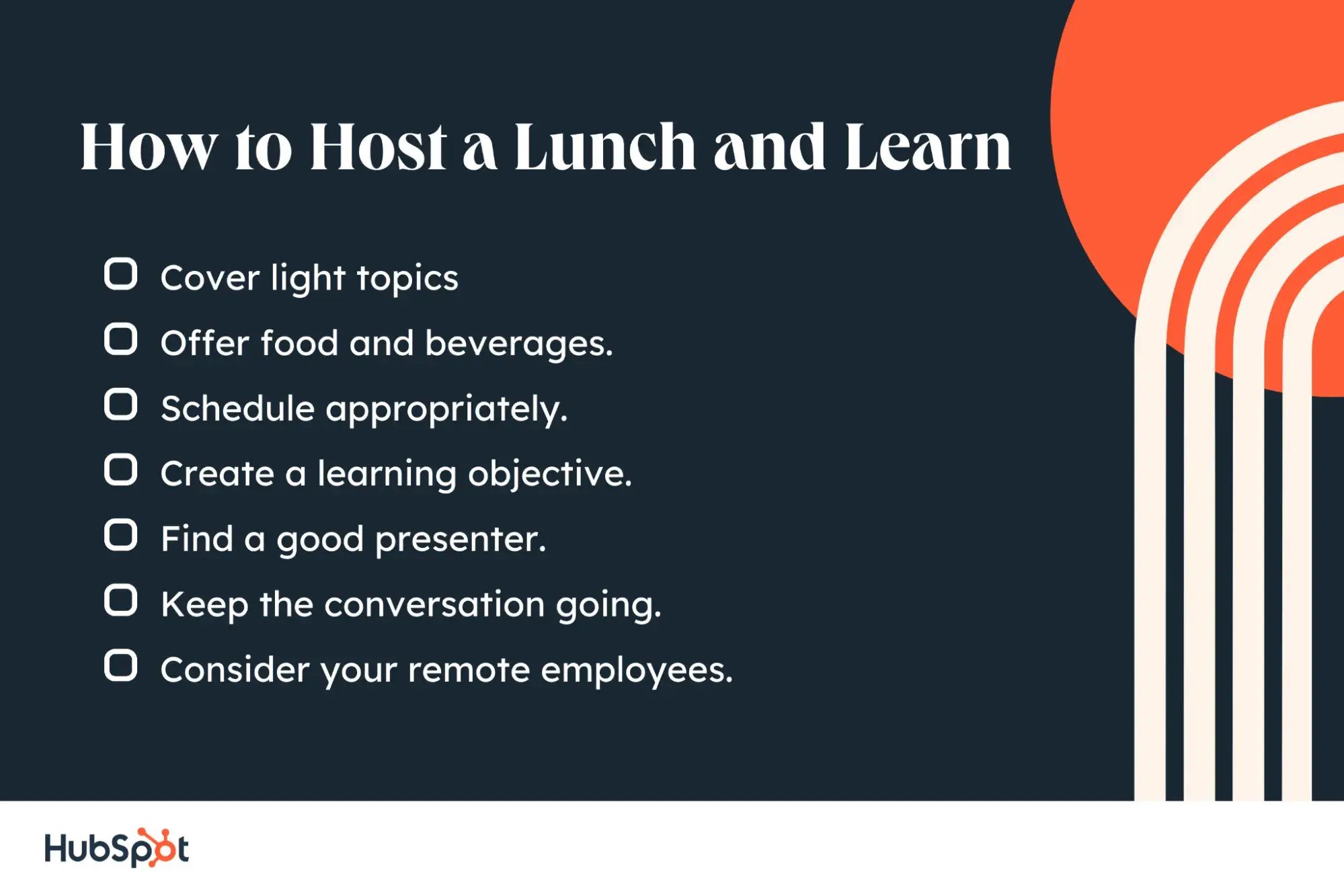
Lunch and Learn Tips
Here are some of my tips for hosting a lunch and learn that your team will want to attend.
1. Make it voluntary.
You can’t force people to have fun. Lunch and learns shouldn’t be an obligation. They should be something your service team looks forward to. Remember that this is their lunch break, so respect that it’s their free time and they can choose how they’d like to spend it.
If reps choose not to or cannot attend, you should offer them a recording or write-up of the key takeaways and resources from the meeting.
Pro tip: Review your state labor laws regarding meal and rest breaks. Some states (like New York) have specific rules for unpaid lunch periods, and if you require work during this time, it’ll need to be compensated. Accordingly, it’s best to make your lunch and learns optional.
2. Crowdsource topics.
Asking your team members what they want to learn is the best way to ensure that your lunch and learn topics are a hit. Crowdsource ideas from your team by sending a survey, email, or quick Slack message. Ask what they have been curious about lately or what they might want to present on themselves.
When the topic of your lunch and learn comes from the team, you’ll experience better turnout, higher levels of engagement, and fewer confessions that “I only came for the free food.”
3. Keep it short and sweet.
Time is of the essence, especially for service teams where time spent away from desks means customer inquiries are piling up.
Lunch and learns should be bite-sized (see what I did there?). Keep it around 45-60 minutes. As much as I would have loved a two-hour lunch break, my eyes would start to glaze over after an hour, and the queue would begin to suffer.
4. Let people eat first.
The structure and flow of your lunch and learn should make sense with the content you’re presenting and the reality that it’s hard to compete for people’s attention when there’s a large pizza in the room.
For example, if your lunch and learn features a physical icebreaker activity, don’t schedule it right at the beginning when everyone is eager to dig in.
Pro tip: The first 10-15 minutes of your lunch and learn is a warm-up. Let people eat, chat, and settle in before serving dessert (dessert being the information).
5. Heed dietary restrictions.
It’s important to accommodate everyone’s dietary needs at your lunch and learn. The last thing you want is for a team member to feel neglected or suffer an allergic reaction.
Check in with your team beforehand to solicit dietary restrictions and preferences and ensure everyone can enjoy the food at your lunch and learn.
Pro tip: Use HubSpot’s Feedback Software to send a quick survey to gather your team’s dietary restriction data.
6. Deliver actionable takeaways.
Make your lunch and learn one to remember by wrapping up with actionable takeaways. Recap key points from your presentation, and consider sending a follow-up email with a short summary and next steps for continued education.
Pro tip: Record the session on your phone and upload the audio file to your AI tool of choice. It can provide a clean transcript or distill the meeting into a few bullet points.
7. Ask for feedback.
Make sure your lunch and learns are a continued success by asking for feedback afterward. You can chat in person or send a quick survey to your reps asking them what they liked, what didn’t land, and what kind of food they’d like to have next time.
It doesn’t have to be overly formal, but asking for feedback helps you make each session more fun than the last and lets your reps know you care about their input.
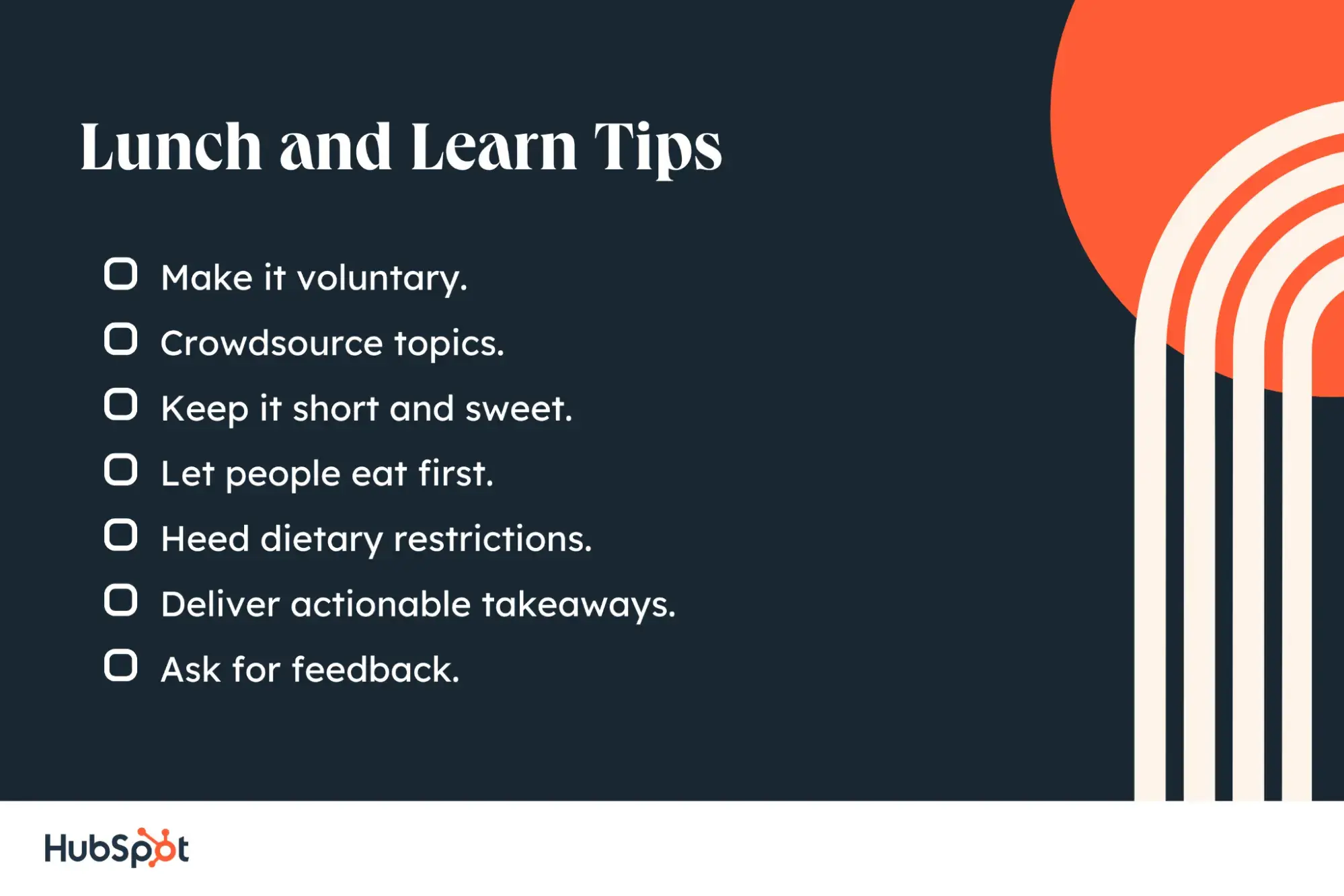
Spreading Knowledge Over Lunch
In my experience, the best service teams provide frequent touchpoints for reps to enhance their professional tool kit. That can include brushing up on specific skillsets or getting time with senior service professionals who can inspire reps’ careers. All that, and more, can be accomplished over lunch.
Editor's note: This article was originally posted in October 2018 and has since been updated for comprehensiveness.
Management

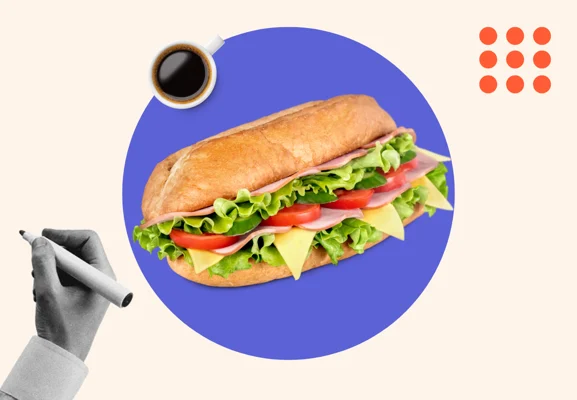
.png)


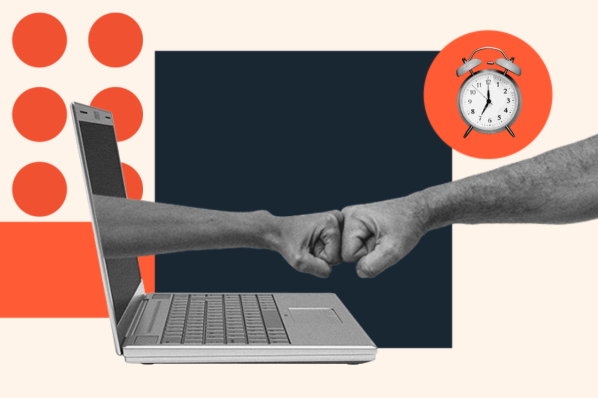

![What Is a Cost Center? [Explained in 500 Words or Less]](https://53.fs1.hubspotusercontent-na1.net/hubfs/53/cost-center.jpg)

